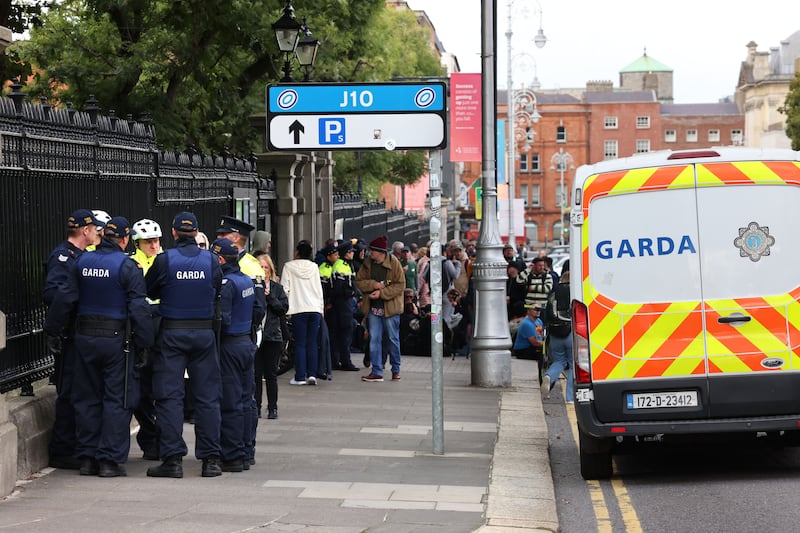“I know what I’d like to do to them,” muttered one prominent TD on Wednesday evening after being told she could not leave Leinster House by car because the Merrion Square gates had been blocked by protesters. “But maybe I’m a direct action kind of person.”
Direct action – very direct action in some cases – is what many TDs, Senators and others working in the Leinster House complex, who found themselves near-prisoners of an unruly blockade, now favour.
In most cases, this involves a much more muscular approach by gardaí against the sort of activity that unfolded on Wednesday – which, they discern, was vicious, menacing and potentially violent. The scenes left many people who encountered them shaken and angry.
They want gardaí to ensure that the home of the national parliament cannot be blockaded again. If the gardaí are going to clear the demonstrators out of the way and arrest those resisting, some TDs argue, would they not be as well to do it at 2pm rather than 6pm?
But others believe it is best not to give those responsible the confrontations they desire. A violent face-off with An Garda Síochána, inevitably filmed on mobile phones and published on social media, is exactly what the hardcore of far-right activists want to help spread their message.

This is the dilemma that the Leinster House authorities, gardaí, the Government and the broader parliamentary system now face: what to do the next time far-right agitators turn up at the gates of Leinster House?
Continue with the containment approach seen during the week and concede the disruption the protest entails? Or toughen the approach up and risk the consequences, which could involve violent clashes resulting in injury and damage on all sides and would be exactly what the agitators are after, creating a notion that they are a force to be reckoned with?
“We can’t have this,” says Seanad Cathaoirleach and Fine Gael Senator Jerry Buttimer of the disruption caused.
A member of the Houses of the Oireachtas Commission, which governs Leinster House and is expected to discuss this issue at its next monthly meeting, Buttimer says “there needs to be a root-and-branch review of security and policing” for events directly outside the parliament.

Disturbance at Dáil Éireann
He has suggested creating a “sterile zone” around Leinster House, meaning protests of this nature would not be permitted to come right up to the gates and stop members and staff coming and going. Protected routes in and out of the complex should be established, he adds.
[ Dáil protests: Use of mock gallows investigated as potential criminal offenceOpens in new window ]
While gardaí are understood to have told the Oireachtas authorities it is possible under public order legislation to have protests moved a mile away, that idea has little support around Leinster House. However, pushing the barriers much farther up Molesworth Street (or Merrion Square on the other side) strikes many as sensible and appropriate. Most TDs who spoke on or off the record were of the view that it was not acceptable to block access to or exit from Leinster House.
People Before Profit issued a tortured statement questioning the Garda’s handling of the protests, and asserting that left-wing demonstrations have been policed in a more aggressive manner. Around Leinster House, many people pointed out that street protests have been an essential part of People Before Profit’s political model. More than that, the party asserts that Government policies, approved by the Dáil, can and should be overthrown by “people power” on the streets.
“I’m wary that these people are getting what they want – attention,” says Senator Rónán Mullen, a member of the Houses of the Oireachtas Commission, of the protesters. “And that’s counterproductive.”
The correct response, he says, “comes down to two things: the enforcement of public order legislation, and minimising the oxygen of publicity for these people”.
Mullen, who is one of the strongest voices campaigning against the Government’s proposed hate crime and hate speech legislation, one of the many topics protested about on Wednesday, is also keen to stress that the unruly scenes should not be blown out of proportion or used to promote the proposed laws.
“We need to be careful not to build this up into more than it was,” he said. “It was a small protest. The gardaí policed it. It wasn’t January 6th (the US Capitol riots). It was a public order issue with a bunch of gougers.”
There is agreement on this point from Labour TD Aodhán Ó Ríordáin, an opponent of Mullen’s on just about every other issue.
“Look, it was a bit uncomfortable for a while, but there was no riot,” he says. “There were no injuries, there was no damage. If I was a guard – everyone went home and nobody got hurt... I’d be happy enough.”
He adds: “I certainly didn’t get the sense that I had never seen anything like this before... Are we going to change the entire basis on which Leinster House operates on the basis of one day? I’m not convinced.”
Ó Ríordáin says that had gardaí confronted the protesters at 2pm “there would have been a running battle” for the afternoon. By the time they moved later that evening, he says, “there were only a few hardliners left”.
The general sense around Leinster House and in Government circles, however, is that there will be a less accommodative policing model in the future, especially when protests take the menacing tone so evident on Wednesday.
Minister for Justice Helen McEntee announced on Friday that she had asked the Garda Commissioner “to undertake a new security and protection review of TDs, Senators, their staff and people working on the Oireachtas campus”.
All eyes are now on budget day, October 10th, traditionally an occasion when various groups assemble around Kildare Street to air their views on a range of issues.



















